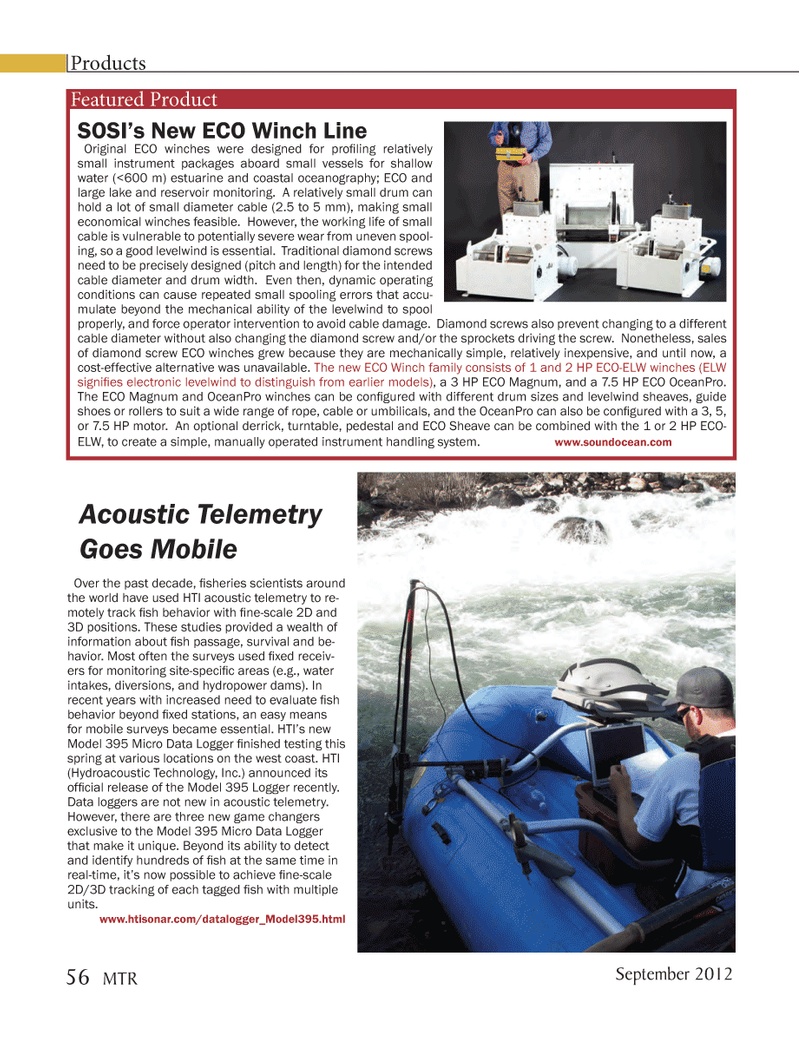
Page 56: of Marine Technology Magazine (September 2012)
Subsea Defense: Protecting Port & Subsea
Read this page in Pdf, Flash or Html5 edition of September 2012 Marine Technology Magazine
Products Featured Product SOSI?s New ECO Winch Line Original ECO winches were designed for pro Þ ling relatively small instrument packages aboard small vessels for shallow water (<600 m) estuarine and coastal oceanography; ECO and large lake and reservoir monitoring. A relatively small drum can hold a lot of small diameter cable (2.5 to 5 mm), making small economical winches feasible. However, the working life of small cable is vulnerable to potentially severe wear from uneven spool- ing, so a good levelwind is essential. Traditional diamond screws need to be precisely designed (pitch and length) for the intended cable diameter and drum width. Even then, dynamic operating conditions can cause repeated small spooling errors that accu- mulate beyond the mechanical ability of the levelwind to spool properly, and force operator intervention to avoid cable damage. Diamond screws also prevent changing to a different cable diameter without also changing the diamond screw and/or the sprockets driving the screw. Nonetheless, sales of diamond screw ECO winches grew because they are mechanically simple, relatively inexpensive, and until now, a cost-effective alternative was unavailable. The new ECO Winch family consists of 1 and 2 HP ECO-ELW winches (ELW signiÞ es electronic levelwind to distinguish from earlier models) , a 3 HP ECO Magnum, and a 7.5 HP ECO OceanPro. The ECO Magnum and OceanPro winches can be conÞ gured with different drum sizes and levelwind sheaves, guide shoes or rollers to suit a wide range of rope, cable or umbilicals, and the OceanPro can also be con Þ gured with a 3, 5, or 7.5 HP motor. An optional derrick, turntable, pedestal and ECO Sheave can be combined with the 1 or 2 HP ECO- ELW, to create a simple, manually operated instrument handling system. www.soundocean.com Acoustic Telemetry Goes Mobile Over the past decade, Þ sheries scientists around the world have used HTI acoustic telemetry to re- motely track Þ sh behavior with Þ ne-scale 2D and 3D positions. These studies provided a wealth of information about Þ sh passage, survival and be- havior. Most often the surveys used Þ xed receiv- ers for monitoring site-speci Þ c areas (e.g., water intakes, diversions, and hydropower dams). In recent years with increased need to evaluate Þ sh behavior beyond Þ xed stations, an easy means for mobile surveys became essential. HTI?s new Model 395 Micro Data Logger Þ nished testing this spring at various locations on the west coast. HTI (Hydroacoustic Technology, Inc.) announced its ofÞ cial release of the Model 395 Logger recently. Data loggers are not new in acoustic telemetry. However, there are three new game changers exclusive to the Model 395 Micro Data Logger that make it unique. Beyond its ability to detect and identify hundreds of Þ sh at the same time in real-time, it?s now possible to achieve Þ ne-scale 2D/3D tracking of each tagged Þ sh with multiple units. www.htisonar.com/datalogger_Model395.html September 201256 MTRMTR #7 (50-64).indd 56MTR #7 (50-64).indd 569/10/2012 10:37:02 AM9/10/2012 10:37:02 AM

 55
55

 57
57
